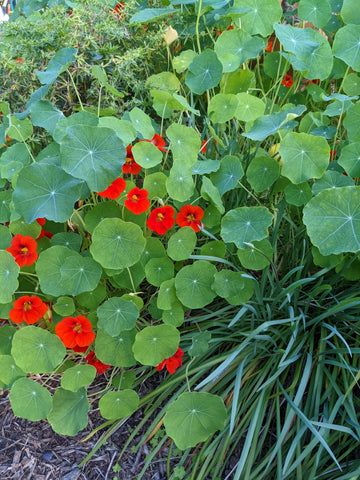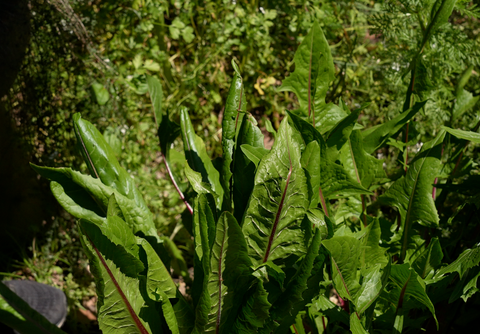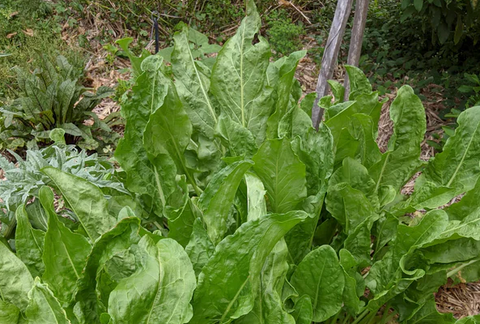No Lettuce? No Worries. Grow These Salad Greens and Herbs Instead!

Salad greens and herbs are easy to grow as well as being tasty and healthy. They also produce an abundance of leaves.
What are the health benefits of salad greens and herbs?
Salad herbs add micronutrients (essential vitamins and minerals) to your diet. They are high in chlorophyll which is a potent blood purifier, blood builder and promotes the growth of new cells in the body.
Some of these herbs also contain mucilage. Plants with high mucilage contents soothe inflammation and irritation in the digestive and respiratory tract. It forms a protective layer on the mucous membranes. Mucilage also helps to clear toxins from our body.
Lots of deep leafy greens mean lots of fibre. Fibre is only found in the cell walls of plants and is essential for healthy bowel function, helping to prevent constipation, haemorrhoids (piles), diverticular disease and cancer of the colon or large bowel. The feeling of fullness that fibre produces can help people who are trying to lose weight, control their appetite.
The best nutrition comes from herbs that are picked fresh from a healthy organic garden. They make the best detox salads!
What are some popular salad greens?
There are so many different salad greens. Some grow all year round - these are called perennials - and others are annuals (completing the lifespan within a year). Some annuals grow better through the cooler months of the year and others love the heat of summer. If you'd like to learn about four great lettuce alternatives, you can watch our video above. Otherwise keep reading to learn about all the great options you can grow yourself below.

Sambung Nyawa - Perennial - All year
Gynura procumbens
Sambung is a vigorous grower providing plenty of leaf with a delicate flavour. This is one to use liberally in the salad bowl or as a spinach substitute. Young leaves and shoots can be sauteed in butter or oil and a little garlic or added to rice or noodle dishes. Add to soups and stews at the end of cooking to add a bit of fresh.

Mushroom Plant - Perennial - All year
Rungia klossii
Its crunchy mushroom flavoured leaves are delicious raw in salads and sandwiches. Another favourite to bulk out the salad bowl. Add the nutritious leaves to quiches and omelettes. It can be added to soups and stir-fries at the end of cooking to keep the crunchy texture.

Okinawa spinach - Perennial - All year
Gynura crepioides
A close relative to sambung. The leaves are green on top and purple underneath and are light in flavour. Okinawa grows quickly providing plenty of colour and crunch to salads and sandwiches. Can be cooked lightly in a stir-fry or rice dish. In Japan, the leaves are dipped in batter and fried and served as Tempura.

Mizuna - Annual - Autumn - Spring
Brassica sp.
The deeply serrated leaves of mizuna make it look like a fancy lettuce. A mild tasting mustard green, it is suitable to use in abundance, an excellent replacement for lettuce in the salad bowl or on a sandwich. Mizuna grows quickly producing masses of nutritious winter greens that can be used like spinach in soups stews and stir-fries.
Salad Burnet - Perennial - Autumn - Spring
Sanguisorba minor
Fresh and cooling with a nutty cucumber flavour that is delicious in salads. Run your fingers along the leaf stem and let the round leaflets fall into the salad bowl, the perfect size as they are. Blends nicely with cream cheese and black pepper as a spread for biscuits and sandwiches. Also nice to flavour vinegars.

Mexican tarragon - Perennial - Spring to Autumn
Tagetes lucida
Mexican tarragon is a perennial plant that dies back in cold weather and shoots away when the weather warms. The leaves have a sweet aniseed flavour adding an interesting flavour to your salads and fruit salads. Use to add flavour to chicken and fish dishes. Mexican tarragon makes a delicious tea.

Endive - Annual - All year
Cichorium intybus
With long crinkly ‘lettuce green’ leaves endive looks great in the salad bowl or tucked into a sandwich or wrap. It has a slight bitter taste so important for igniting our digestion. Tastes delish on a toasted sandwich with your favourite cheese.

Nasturtium ‘Alaska’ - Annual - Autumn - Spring
Tropaeolum majus
Flowers ranging from pale yellow through to deep orange add vibrant colour to salads and make pretty garnishes for any meal. The leaves are peppery and are variegated with splashes of white over green. Adds a nice zing to salads.

Nasturtium ‘Empress of India’ - Annual - Autumn - Spring
Tropaeolum majus
The deep orange flowers add a striking contrast of colour to the salad bowl as well as a peppery bite. Small leaves can be added whole to a salad or sandwich or tear larger leaves to bite size pieces. Large leaves can be used as wraps for small amounts of salad or other tasty morsels.

Mustard Streaks - Annual - Autumn - Spring
Brassica sp.
Hotter than mizuna with ferny lime green leaves, this asian green adds interesting shape as well as mustard flavour. Leaves can be added to salads, sandwiches, soups and stir-fries. Chop into white sauce to liven up a bowl of steamed veges.

Mizuna Purple - Annual - Autumn - Spring
Brassica sp.
The finely indented leaves with purple colouring add an interesting visual. Crispy texture, purple colour and mustard flavour adds interest to salads. It may also be used in stir-fries, soups and stews like other leafy green vegetables.

Red Dandelion Chicory - Perennial - All year
Cichorium intybus
This chicory looks a little bit like dandelion. The green toothed leaves with red ribs look nice in salad and add their bitter goodness to salads, sandwiches and stir-fries.

Treviso Chicory - Annual - All year
Cichorium intybus
Also known as radicchio treviso chicory is a favourite Italian salad green. The leaves are green in summer and turn red and white in cold weather. Use the young leaves in salad mixes or just make a salad of treviso with a creamy garlic dressing. The older plants can be cut into wedges and grilled then topped with your favourite dressing.

Giant Red Mustard - Annual - Autumn - Spring
Brassica juncea
The reddish/purple leaves add a hot mustard flavour to salads. The leaves can also be added to pickle liquid for taste and colour. Blend leaves with olive oil to make hot mustard sauce, this can be incorporated into a salad dressing.

Sorrel - Perennial - All year
Rumex acetosa
The tart, lemony leaves can be pulled from the base of the plant by hand, discard the stem and use the leaves to flavour soups, sauces and salads. Sorrel leaves partner well with avocado in a salad or on a sandwich. Add some shredded leaves to scrambled eggs, omelettes and frittata.

Moringa - Perennial - Spring to Autumn
Moringa oleifera
The leaves have a nutty and slightly mustardy flavour and can be added to a salad, made into a tea. You can also use the leaves like spinach by steaming or stir-frying in oil. The pods (drumsticks) and roots are also eaten. All parts of the Moringa are very nutritious.

Wild Rocket - Perennial - Spring to Autumn
Diplotaxis tenuifolia
Wild Rocket is an ideal replacement for normal Salad Rocket it has a more intense and pungent flavour, it adds a distinctive taste to green salads. It may be used as a garnish on pizzas, meat dishes or in a sandwich. The flowers are also edible and can be added to similar dishes.

Amaranth ‘Garnet Red’ - Annual - Spring to Autumn
Amaranthus tricolour
A striking plant in the garden self seeding each year. The young leaves add colour and nutrition to salads and stirfries. Use the older leaves like spinach, nice quickly stirfried in a bit of olive oil or butter.

Red Sorrel - Perennial - All year
Rumex sanguineus
The interesting patterned tart leaves can be torn into salads or the small young ones left whole. Chop and add to sauces and soups, salads and omelettes.

Purple Mukunu Wenna - Perennial - Spring to Autumn
Alternanthera versicolour
The purple red leaves add a striking contrast when used either cooked, raw or as a garnish. The nutrient-rich leaves have a bland taste but mixed with other greens make for a healthy colourful salad. Cook up like spinach by steaming or stir-frying with a little garlic and olive oil.

Dandelion - Perennial - All year
Taraxacum officinale
Young leaves are less bitter than older ones and can be used in salads and sandwiches. The leaves can also be used as a replacement for spinach in frittatas and omelettes and as a side green. Flowers can be used as an edible garnish. The dried, roasted roots of the plant are used to make dandelion tea and ground ‘coffee’.
Simple Salad Dressing
Feeling inspired? This salad dressing is my standard go-to for salads. I like to have some made up and I keep it in the fridge so it is ready to go in a pinch.
- 200ml Olive oil
- 100 ml lemon juice
- 1 small clove garlic crushed or grated
- 1 tbsp of chives
- 1tsp grainy mustard
Mix all of the ingredients in a jar or bottle and shake to combine. Shake before use as the oil and juice separate.
Unsure where to start?
We've all fallen in love with going garden to plate, and we want you to have that same experience. This Salad Herb Starter pack is great if you want to start growing delicious salad herbs in your garden that are low maintenance and grow throughout the year. It has Sambung, Mushroom Plant, Salad Burnet and Nasturtium (Alaska) - a delicious combination! Or if you're looking for a specific plant, check out our collection of salad herbs.




